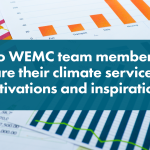Climate data: Quantity vs Quality
Climate data is more reliable now than ever, with weather forecasters using advanced technology to collect, analyse data and produce complex models with increasing accuracy. This information is used to collate climate data outlining the average weather experienced in a particular area over 30 years or more.
Quality historical climate data
As part of the Copernicus Climate Change Service (C3S), WEMC along with Météo-France, CEA, ARMINES, EDF and the Met Office developed an operational climate service for the energy sector within the C3S Energy project (2018 to 2020). This built on the work of the two previous C3S Proof-of-Concepts (POCs) CLIM4ENERGY (C4E) and European Climatic Energy Mixes (ECEM), including their demonstrators.
A key aspect of this work was the consultation and service co-design with the energy industry. It produced energy indicators for electricity demand, wind power, solar power and hydro power for three streams: historical (last ca. 40 years), seasonal forecasts and projections (to 2100. The historical data products are available to all through a demonstrator application hosted by the Climate Data Store. Data is provided for the European domain, in a multi-variable, multi-timescale view of the climate and energy systems. This is beneficial in anticipating important climate-driven changes in the energy sector, through either long-term planning or medium-term operational activities. This is also used to investigate the role of temperature on electricity demand across Europe, as well as its interaction with the variability of renewable energy generation.
Two case studies with energy providers (E.ON UK and Envision) were undertaken to illustrate the added value of energy variables and the derived products to minimise operational costs for the energy industry. These provided a baseline comparison using climatology or existing products against the optimized and tailored state-of-the-art seasonal and climate products used in this operational service.
Use Teal to access free quality historical climate data
Climate data and information is often only available as raw observations or in the form of tables, graphs, or written summaries, which may be difficult for non-expert users to fully understand and interpret. WEMC’s Teal tool bridges this gap by visualising historical climate data in an accessible and easy to use format, allowing users to better understand the information and apply it to their decision-making processes.
Developed by WEMC, Teal is a free easy-to-use visual tool that enables you to explore climate variables and carbon emissions for the past 40+ years, from 1980 to near real time. For our datasets, Teal uses historical reanalysis data (ERA5) obtained from the Copernicus Climate Data Store (CDS). Data from the climate data store is open-source and freely available to anyone who creates an account there.
We choose ERA5 historical data as it is quality-assured, updated in close to real-time and at high resolution, meaning that data is available down to hourly resolution and at a 0.25 degree grid, across the entire globe. Reanalysis means it combines historical observations with advanced modelling and data assimilation systems.
For our country and regional averages, we use shapefiles from the open source and trusted, Natural Earth website and Eurostat NUTS2 for the European regions.

Conclusion
Access to high quality data is a key factor in making effective weather-based decisions in the commercial sector especially with increasing reports of extreme weather events. As part of WEMC’s initiative to engage with users within climate sensitive sectors, we are undertaking regular updates to maintain the quality of data supplied within Teal. We use ERA5 historical data due to its high quality, which in turn provides users with reliable, quality information to make decisions where historical climate data is a crucial factor. Historical climate and energy data helps understand and learn from the past to move forward.
Keep updated on Teal and share with us what you discover using Teal on Instagram, Twitter and LinkedIn. We are keen to hear how you use Teal as a resource within your specific sector.




